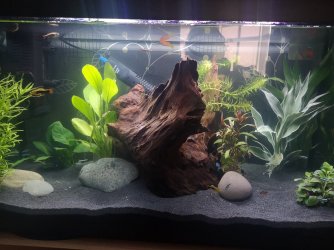Treestone
Fish Fanatic
First thing to get clear is the needs of certain fish species with respect to the substrate. Corydoras catfish were mentioned, and these are filter feeders. They take in a mouthful of sand, filter out tiny food bits, and expel the sand via the gills. Some sand is also swallowed with the food. These fish all live over substrates of fine river sand or mud, or a combination. They are filter feeders, and if we care about the wellbeing of our fish we must be willing to provide accordingly. You can appreciate what risks are present if we put a rough sand in the aquarium with such fish.
That's one factor. Another that is related to sharpness/roughness is the barbel erosion risk. Self-obvious. And then there is the bacterial issue. The larger the grain size of the substrate, the less efficient is the breakdown of organics by bacteria. This causes bacterial issues for catfish barbels.
To the black sand...fish react to the substrate. Corydoras maintained over white substrates will have less intense colouration because of the substrate. The same works in reverse; black is not "natural" and the fish internally react and may darken their body colouration. In both cases it is a response of the fish to adverse (stressful) conditions brought on by the substrate. The fish has no control, this is something of an automatic reflex.
Aquarists often confuse what they want with what their fish require.
I thought it was a matter of feeling safer over a black substrate that the fish have more pronounced colours and over a bright substrate they feel unsafe and therefore stressed. My only problem with what your saying is a black substrate isn't naturally occurring. Iron sand appears in multiple areas around the world. In a heavily hardscaped/or planted tank would this be such an issue?


